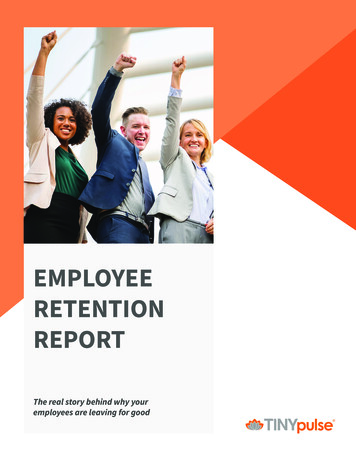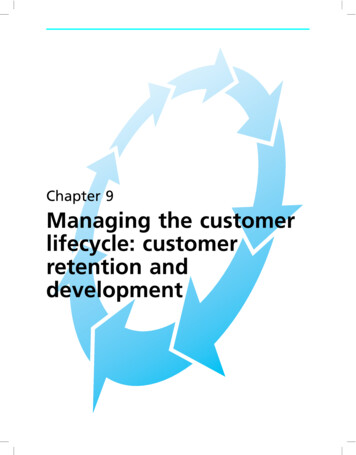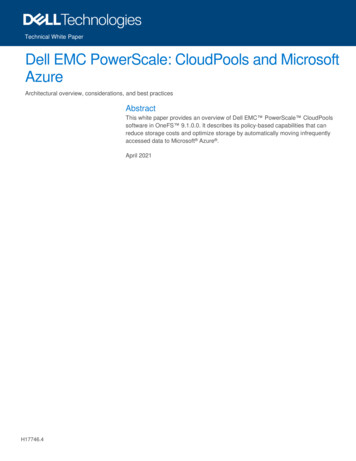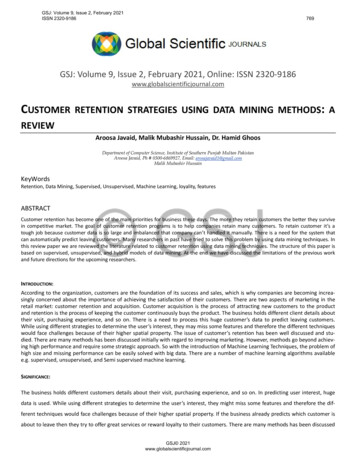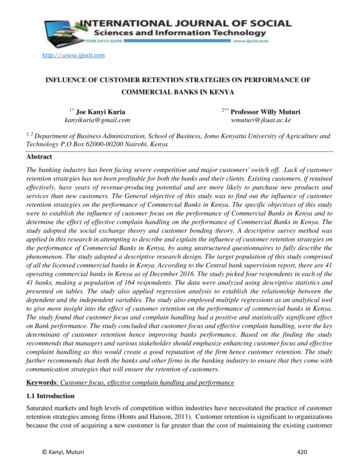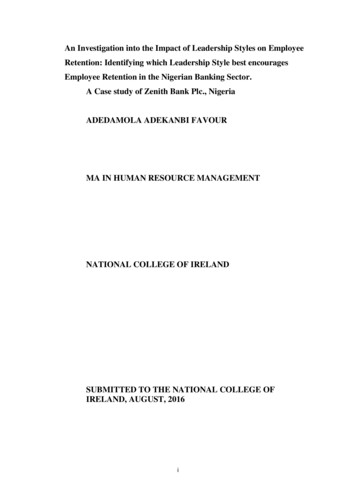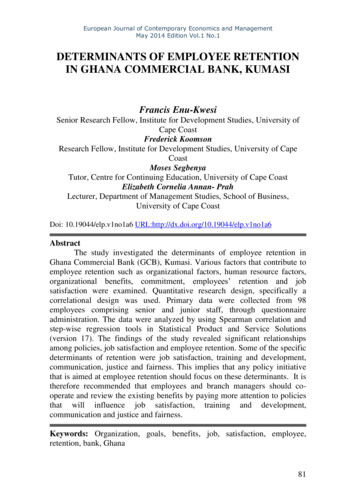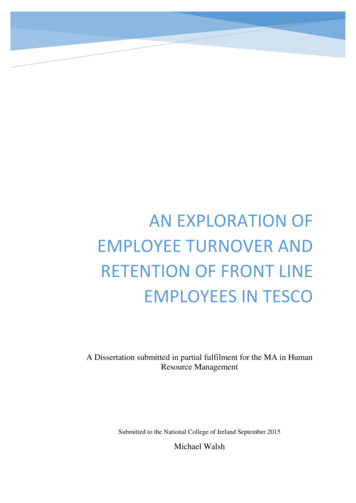
Transcription
2020RETENTIONREPORTInsights on 2019Turnover Trends,Reasons, Costs 1-888-750-9008
Successful organizationsfind the people necessaryto do the work that needsto get done.
2020 RETENTION REPORTTABLE OF CONTENTS4DEAR EMPLOYERS5EXECUTIVE SUMMARY6STATE OF THE WORKFORCE12 Voluntary Turnover Continued in Intensity andSeriousness Total Turnover – Voluntary and Involuntary Competition for Workers Intensified Voluntary Turnover Costs Exceeded 630Billion First Year Turnover Continued to PlagueEmployersTURNOVER CATEGORIES Categories of Reasons for Leaving in 2019Career DevelopmentWork Life BalanceManager BehaviorJob CharacteristicsWell-BeingCompensation & BenefitsWork Environment25ADDITIONAL INSIGHTS32PREDICTIVE ANALYTICS –SIMPLIFIED35WHAT ORGANIZATIONS MUST DOTO INCREASE RETENTION37ABOUT WORK INSTITUTE38ABOUT COHRE39ABOUT THE AUTHORS Turnover Segmented by SexTurnover Segmented by AgeTurnover Segmented by TenureTurnover Has to be ManagedEmployees Increasingly Frustrated with Joband Stress Manager Behavior is a Red Flag and It Is GettingWorse3
2020 RETENTION REPORT INTRODUCTIONDEAREMPLOYERS,This year’s Retention Report retains many of thefeatures readers have come to expect as we continueto increase our data set, review additional humancapital intelligence, explore new areas, and understandnew ways to retain employees. Work Institute’sRetention Report is the expert employee retentionresource for organizational leaders and businessmedia, including USA Today, Bloomberg, CNN, and TheWall Street Journal.It is important to note we were nearing the endof producing our 2020 Report when the COVID-19pandemic began. This crisis creates unprecedentedcircumstances for employers. It is difficult to knowhow the COVID-19 situation will impact organizationsand employees. Regardless, we have decided to keepthe content of this Report largely intact as it primarilyreflects 2019 data.The publication of this report is the product of manyhands. I am particularly grateful for the contributionsof various Work Institute professionals includingWilliam Mahan (marketing), Christopher Ashford(data analytics), Glen Spinner (client success),Katherine Huddleston (operations), and RichardNicorvo (finance). I am additionally appreciative to theIndustrial/Organizational Psychology team at MiddleTennessee State University. Employee retention isa serious concern. Viewing it through the lenses ofmultiple disciplines strengthens its value.4Leadership today requires understanding the needto be competitive in the fight for talent that will likelyreturn in the coming months. As trends emerge, theneed for urgency is real as companies are impacted bythe current crisis.In my role as a workforce and workplace behaviorexpert, I interact daily with leaders on their challengesin attracting, retaining, and engaging their workforce.Many business executives listen to and act onemployees’ recommendations. These leaders haveskilled employees who stay.Employers can identify and create the necessaryconditions wherein employees will engage and stayeven in the face of adversity. Winning the talent warwill enable organizations to weather the currentstorm and return to prosperity more quickly. Now istime for all leaders to study, report, act, evaluate, andcommunicate with urgency.We stand watch together with you learning how ourfuture unfolds.Danny NelmsPresident, Work Institute
2020 RETENTION REPORT INTRODUCTIONEXECUTIVE SUMMARYOrganizations CAN and MUST become better employers to retain and engage employees.Work Institute conducts employee interviews toaccurately identify why employees choose to stayor quit, uncovers remedial actions, and helpsorganizations improve retention and engagement toreduce human capital expense. This 2020 RetentionReport utilizes data from over 233,000 employeesfrom 2010 through 2019, including data from 34,312employees who quit their job in 2019. Additionalanalysis was conducted using Stay Interview data from3,618 respondents.The top 3 categories for leaving in 2019 were CareerDevelopment (19.6%), Work-Life Balance (12.4%),and Manager Behavior (11.8%). The four reasons withthe largest gains, appearing more frequently than inthe past, are culture-employee misfit, unsafe workenvironment, poor communication, and general jobcharacteristics. Manager Behavior has seen greatfluctuation over the years with six of the eight reasonsfor leaving changing by more than 50%.Work Institute gathers ratings on Core Drivers.Interviewees who gave a “poor” rating to theirprevious employer, supervisor, and job primarily chosemanager behavior for their most important reasonto leave, while those who gave their previous teama “poor” rating selected work environment for theirmost important reason to leave. Current employeeswho gave higher ratings to their supervisor, the jobitself, and their team intend to stay longer with theirorganization.The odds of deciding to leave decrease by 31.8%, 12%, and 5.3% for every1-point increase in the core driver ratings for supervisor, job, and team, respectively.The odds of deciding to leave decreases by 3.4% for every interviewee age increase.The total cost of employee turnover for businesses is high, evenby conservative estimates, taking a toll on company profits.Voluntary turnover was up an additional 2 million over 2018 bringing thetotal to over 42 million in 2019. Turnover continued to add significantoperational costs to employers, compromising growth and profit.5
STATE OF THEWORKFORCETrends in the United States illustrated athriving economy in which the numberof available jobs and the competition forworkers were both sharply increasing.The Bureau of Labor Statistics expectedeven further job growth and a talentpool that is not keeping pace.
2020 RETENTION REPORT STATE OF THE WORKFORCEVOLUNTARY TURNOVER CONTINUEDIN INTENSITY AND SERIOUSNESS42 millionShould this trend continue, more than one in three workers willvoluntarily quit by 2023.U.S. workers decided there wassomething better elsewhere.There were over 158 million people actively working in the U.S.job market. This number had steadily risen since the recoveryfrom the recession began in 2009. Unemployment ended theyear at a fifty-year low.More than 27out of every 100Unfortunately, the number of U.S. workers leaving their jobs hadalso risen steadily. In 2019 over 63 million workers voluntarilyleft, were laid off, or left their job for other reasons.U.S. employees quit in 2019.Three of every four workers that left their job did so voluntarily.U.S. VOLUNTARY 023Turnover trends demonstrated an 8.3% increase over 2018 and 88% increase since 2010.7
2020 RETENTION REPORT STATE OF THE WORKFORCETOTAL TURNOVERVOLUNTARY AND INVOLUNTARY65 millionAlthough organizations tend to focus on voluntary turnover,there is also a significant number of separations due to layoffsand discharges.Total Separations in 2019SAN JOSEDALLASDischarges and layoffs have largely stayed flat since 2013,but there are still costs associated with these (involuntary)departures.SAN DIEGOSAN ANTONIOPHILADELPHIAPHOENIXHOUSTONCHICAGOThe total number of separations in 2019 was roughlythe combined populations of New York, Los Angeles,Chicago, Houston, Phoenix, Philadelphia,San Antonio, San Diego, Dallas, San Joseand the next 15 largest U.S. cities.LOS ANGELESNEW YORKU.S. TOTAL EMPLOYEE ,000,00020,000,00010,000,0000201020112012Total 2018Voluntary Terms2019
2020 RETENTION REPORT STATE OF THE WORKFORCECOMPETITION FORWORKERS INTENSIFIED7 millionWork Institute predicted the supply and demand crisis in our firstRetention Report in 2017. Even then, job openings compared tounemployed workers was nearing the tipping point.Job openings in 2019 6 millionThe continuation of this trend fuels the war for talent in the U.S.job market. Employers are faced with the challenge of attractingemployees from other companies rather than the easier task (severalyears ago) of recruiting them from a ready unemployed supply.Unemployed in 2019SUPPLY AND ob Openings201420152016201720182019UnemployedBecause 2019 ended with a 3.5% unemployment rate,the necessity to retain workers remained crucial.9
2020 RETENTION REPORT STATE OF THE WORKFORCEVOLUNTARY TURNOVER COSTSEXCEEDED 630 BILLIONTurnover costs occur when employees leave the organization and mustbe replaced. Turnover effects productivity, increases training time,increases employee selection time, and decreases efficiency. It alsoeffects longer/more frequent training times, interrupted schedules,additional overtime, increased mistakes, increased frustration with nothaving skilled, knowledgeable, and experienced employees in place,and negatively impacts existing employees.What does turnover cost inyour organization?How many people quitin your organization in 2019?Multiply by 15,000**x Annual Turnover Cost/Baseline *Turnover cost is based on four factors. These include:1. Cost of Termination2. Cost of Replacement3. Vacancy Cost: number of days job is open times the average valueof the job per day4. Learning Curve (productivity) Loss: revenue per employee per daytimes number of days it takes to get the new hire up to standardperformance.*This is your baseline turnover cost.WHAT WILL THIS BE IN 2020?**The median income for a salary workerin the U.S. translates to a yearly incomeof approximately 48,672. Work Instituterecommends (conservatively) costing turnoverat 30%, approximately 15,000 per employeedeparture.COSTS OF VOLUNTARY EMPLOYEE TURNOVER ( 01620172018There are costs involved with employee turnover regardless ofwhether an employee leaves voluntarily or involuntarily.102019
2020 RETENTION REPORT STATE OF THE WORKFORCEFIRST YEAR TURNOVER CONTINUEDTO PLAGUE ORGANIZATIONSOver one-third (37.9%) of interviewees exited their organizationwithin 365 days or less. Two out of three employees who leave inthe first year do so in the first six months.First Year Turnover GroupTake a deep dive into your employee turnover feedback tounderstand what drives this population to exit within six monthsof hire.PercentFirst 30 Days19.331 - 60 Days10.261 - 90 Days10.891 - 180 Days23.2181 - 270 Days19.4271 - 365 Days17.1TURNOVER WITHIN FIRST rlopmenentt0%First 30 Days31-60 Days61-90 Days91-180 Days181-270 Days271-365 DaysFirst Year Turnover is Expensive. Employees who leave in the first ninetydays deliver little-to-no return on the investment made to hire them.11
TURNOVERCATEGORIESCareer Development was the leading categoryof employee turnover. Job Characteristics wasan increasing cause of turnover. Organizationsmissed the mark on interventions to supportretention. Employers need to attend tothe turnover and stay reasons unique totheir company to increase retention.
2020 RETENTION REPORT TURNOVER CATEGORIESCATEGORIES OF REASONSFOR LEAVING IN 2019Work Institute codes reasons for leaving into ten categories. Thesecategories represent fifty-two distinctly different reasons employeesleave their employer. Furthermore, Work Institute identifies them asthem as more or less preventable.More or Less Preventable –What Is and What Is Not Controllable?Turnover categories can be identified as more preventable or lesspreventable. Seven of the ten categories Work Institute identified canbe labeled as preventable.Involuntary6%78%of the reasons employees quitcould have been prevented bythe employerThree in Fouremployee turnoversare preventableWork Environment6%Career Development20%Retirement6%Compensation &Benefits9%Work-life Balance12%Relocation9%Manager Behavior12%Well-Being10%Job Characteristics10%13
2020 RETENTION REPORT TURNOVER CATEGORIESCATEGORY #1CAREER DEVELOPMENTCareer Development as a category for leaving had increased17% since 2013.20 out of 100employees quit for careerdevelopment reasons in 2019 No advancement or promotional opportunity hasdeclined since 2010. Lack of growth & development opportunity continued totrend up since 2010. Type of work, trending down since 2013, took a sharpdecline 2018 to 2019.TRENDS IN CAREER DEVELOPMENT REASONS FOR LEAVING10%Type of Work9%Percent of All 5%4%Promotion &Advancement3%2%Job Security1%0%Career r Development has been the #1 Category for ten straight years.Employees who are satisfied with their development are likely to stay.14
2020 RETENTION REPORT TURNOVER CATEGORIES2019 CAREER DEVELOPMENTResponses and Potential SolutionsREASONSOLUTIONLACK OF GROWTH/DEVELOPMENTTraining/Succession I went to school and got my degree in nuclear medicine technology. They did not give me the opportunity in thatfield after working there for 5 years. I didn’t feel like there was any more room for me to grow, I was there over 4 years and I did not receive a raise. There is very little room for growth opportunities. People with disabilities, such as myself, are not considered foropportunities. We were told there were no opportunities for IT, we would have to do our own career planning.NO ADVANCEMENT/PROMOTIONALSuccession/Communication I left because I was approached by another organization that offered me an incredible opportunity for promotion. I didn’t feel there much opportunity for me to advance in my position. After almost 6 years I needed to move on tosomething where I would continue to learn and can apply my skills that would benefit others. A promotion opportunity was available, and someone was hired with dramatically less experience than me.TYPE OF WORK Job Preview/Selection Process/AssessmentsI found a new job that was more suited for my career path.The job description was not what I was told it would be.I left the company because I felt like the job was not a good fit for me.I left the company because the job description did not match what I wound up doing. It was not a good fit for me.RETURNING TO SCHOOLAsk about Manageable Options I am going to school and could not work the hours that they wanted me to. I left because I went back to school to increase my knowledge. I got accepted into medical school.JOB SECURITYCommunication/Work Environment There was instability in the job, there was a false sense of security and I needed a job that I did not have to worryabout the future. The turnover was bad here. I could not do my job right because the turnover was horrible. There was upheaval and chaos. My supervisor was let go and not replaced. No one was communicating with us whatwas going on with the company and our department, so we were worried about job security.GENERAL CAREER REASONAsk about Manageable Options I started my own business. I started working from home for myself. I wanted to travel around in general.15
2020 RETENTION REPORT TURNOVER CATEGORIESCATEGORY #2WORK-LIFE BALANCE12 out of 100As a category, Work-Life Balance was up 23% since 2013. Schedule remained the top reason in this category.employees quit for work-lifebalance reasons in 2019 Commute has increased 334% since 2010. Schedule flexibility was trending down.TRENDS IN WORK-LIFE BALANCE REASONS FOR LEAVING10%9%Percent of All Reasons8%Schedule7%Commute6%5%Schedule 52016201720182019What are your scheduling issues? Do your employees perceive a fairness orfavoritism issue? Knowing the real reasons will help retain your employees.16
2020 RETENTION REPORT TURNOVER CATEGORIES2019 WORK-LIFE BALANCEResponses and Potential SolutionsREASONSCHEDULE SOLUTIONCommunication/Adaptability/Job PreviewI left the company because the schedule was not working for my kids and my family. I was working 12 hours.I was offered an opportunity in which I do not have to work any weekends at all.I left because the hours did not work for my family. The length of hours, 12-hour shifts did not work for me.I left for a job with better hours. I was working 12-13 hours a day now I work 8-9 hours a day.SCHEDULE FLEXIBILITYCommunications/Flexibility I am mostly working on 2nd shift. I need to work on daytime. It was difficult to take time off for school events for my son or anything like that. I would have to request vacation ayear in advance. It was just in my department that worked this way. I was a student and the work hours did not fit around my school schedule. I needed more flexibility. I was having to work too much and that was not fitting into my personal life.COMMUTEFour-day Week/Telecommute/Options The drive was too far. I lived about 40 miles away. I spent about 2 hours a day driving. I resigned because the company was relocating the new office; it was going to be too far for me to travel. I ended up traveling too far and having to get up at 3 AM every day. It was a lot of traffic and it made getting to mypatients on time impossible. I had a 2 hour commute each way. I did it for a year and hoped there would be a more flexible way to work on thephones, but it seemed so hard to accommodate me working from home. I left because the commute was very far. I was falling asleep on the road. I left because of policy changes. The company allowed us to work from home full-time, and they changed that. I left because the commute was too far. I was told that I would be commuting 3 hours one way; 6 hours driving wasnot going to work for me. I was traveling a little too much, 4 hours one way to work took a toll on me.TRAVELExplore Options I was not being compensated for my mileage. I was hired for one county but was transferred to another county thatwas 70 miles away. I definitely don’t feel like traveling anymore. The job required a lot of travel. I wanted to go back to an office typeenvironment. I decided to take a traveling position.17
2020 RETENTION REPORT TURNOVER CATEGORIESCATEGORY #3MANAGER BEHAVIORManager Behavior has seen fluctuation since 2010 with sixof the eight reasons for leaving changing by more than 50%.12 out of 100employees quit for managerbehavior reasons in 2019 Only three of the eight reasons (unprofessionalism, uppermanagement, manager fairness) had improved in the lastyear. Unprofessionalism, while improved remained high. Poor employee treatment, lack of support, and lackof management competence had not shown anyimprovement from 2018 to 2019. General behavior and communication have eachincreased (gotten worse) in the last year.TRENDS IN MANAGER BEHAVIOR REASONS FOR LEAVING4%Employee TreatmentPercent of All ssionalism1%CommunicationUpper 19Organizations must ensure managers are well-trained in relationship skills and conduct or continueto lose the talent war. How is general management behavior perceived in your organization?18
2020 RETENTION REPORT TURNOVER CATEGORIES2019 MANAGER BEHAVIORResponses and Potential SolutionsREASONPOOR EMPLOYEE TREATMENTSOLUTIONDevelopmental Coaching/Remedial Counseling/Training I didn’t see eye to eye with my manager. I think she was trying to get rid of me anyway. My supervisor caused a hostile work environment. She would verbally attack me in front of everybody. She wouldscream at me in meetings a lot. This started around April of 2019 and it continued through June of 2019.LACK OF MANAGER COMPETENCESelection/Developmental Coaching/Remedial Counseling/Training My manager was never there and did not know what was going on. I was being harassed and bullied by my supervisor. Everyone complained she was doing drugs. I reported her and itwas supposed to be confidential, but she found out and started bullying me. I felt like I was treated wrongly.MANAGER FAIRNESSSelection/Developmental Coaching/Remedial Counseling/Training I left because of a conflict with my direct manager and her superior. She treated blacks and whites differently, andalso treated the patients poorly. I tried to get to talk with someone in HR, but they kept blowing me off.GENERAL BEHAVIORSelection/Developmental Coaching/Remedial Counseling/Training I left because I did not like the fact that I was micro-managed by the director. I have a lot of experience in this field,and if my direct supervisor gave me autonomy, then she should have as well.LACK OF SUPPORTPolicy/Selection/ Developmental Coaching/Training I left because I had a death in the family, and one of the administrators said something inappropriately right after. Istarted looking for another job right after.UNPROFESSIONALISMSelection/Developmental Coaching/Remedial Counseling/Training I left because of the management. They are not friendly at all. Every chance they got; they would belittle me. Theyacted like I did not understand what was going on. I spoke to them about this and nothing changed.POOR COMMUNICATIONSelection/Developmental Coaching/Remedial Counseling/Training They did not give us the communication we needed. One minute things would be done one way and the next minute things were done differently. Policies kept changingand communication was not good.UPPER MANAGEMENTSelection/Developmental Coaching/Remedial Counseling/Training There were a lot of issues that were not being addressed by upper management. I left the company because of how management was treating employees. I felt that the head manager did notrespect employees and had no problem cursing at the employees.19
2020 RETENTION REPORT TURNOVER CATEGORIESCATEGORY #4JOB CHARACTERISTICS10 out of 100Job Characteristics was the number one rising category ofturnover, up 117% since 2013.employees quit for jobcharacteristics reasons in 2019 The percent of interviewees citing general jobcharacteristics as the most important reason for leavinghas increased substantially since 2012. Workload issue was the second most cited reason forleaving in this category. Limited resources and poor training were leveling off butstill appear more frequently than in 2010.TRENDS IN JOB CHARACTERICS REASONS FOR LEAVING6%5%Percent of All ReasonsLimited Resources4%Lack of EmpowermentGeneral Job Characteristics3%DissatisfactionPoor Training2%Task or Role 19What are the actual tasks you are hiring for versus the ones you tell candidates?Realistic job previews and responsible selection assessments reduce job characteristic disconnects.20
2020 RETENTION REPORT TURNOVER CATEGORIES2019 JOB CHARACTERISTICSResponses and Potential SolutionsREASONGENERAL JOB CHARACTERISTICSSOLUTIONJob Previews/Selection Systems/Interview Skills The work is extremely physical work. When I am there I am sweating profusely. I am also sore all over at the end ofmy shift. I was forced into doing a job that I was not hired to do. I left the company because the work that I ended up doing in my job was not what I signed up for when I took theposition. I left the company because it was not the job that I applied for. What I was told about during the interview wasnothing like what they were having me doLIMITED RESOURCESManage excessive turnover I started to feel uncomfortable at the job. It felt unsafe. The staffing was low for the acuity of the patients. I left the organization because I did not like the working conditions. There were not enough people there to handleall the work and they would not hire more people. The company was always short staffed, and I was not able to do my job to the fullest. I left the company because I felt that we did not have the proper resources with tools and people to get the job done.LACK OF ment Was not provided the authority commensurate with my responsibility to run the project. There was no autonomy; we were told to do what we were told, or they basically made us feel unwanted. They claimthey want retention, but I feel that is just words.DISSATIFIED WITH WORKJob Characteristics Hated it, my responsibilities were not at all what I was led to believe. I feel like this job was not for me. It was just something I could not be comfortable with.POORLY TRAINEDSkill and Knowledge Development They changed over to a new system in computers. I am 69 years old I did not want to go through another change.There is a lot of problems with the new system. We only received a couple of hours of training on the new system. The proper training was not given to me and so I was not doing well.TASK OR ROLE OVERLOADExcessive Demands/Understaffing/Role Definition I was stressed out begin out in the field. The job was not for me anymore. I needed to slow down. I am leaving because I felt stressed about the job all the time. I am concerned about my health with all this stress.21
2020 RETENTION REPORT TURNOVER CATEGORIESCATEGORY #5WELL-BEING9 out of 100Job stress, being overworked, and lack of support to taketime off were concerns facing U.S. workers.employees quit for well-beingreasons in 2019 Pregnancy and family issues continued to trenddownward Personal, general, and care-giver issues have increased inthe past year.TRENDS IN WELL-BEING REASONS FOR LEAVING4%Percent of All ReasonsGeneral Personal3%Personal HealthCaregiver Issues2%Pregnancy1%Family sed on your employees’ opinions, is employee well-being a priority at your organization?To promote work-life balance consider flextime and telecommuting, assistancewith childcare/eldercare, financial counseling, and flexible leave options.22
2020 RETENTION REPORT TURNOVER CATEGORIESCATEGORY #6COMPENSATION & BENEFITSWhile benefits represent a small percentage of theoverall number of people who voluntarily quit their job, itcontinued to trend upward.9 out of 100employees quit for compensation &benefits reasons in 2019 Compensation has seen modest gains since 2010. The percentage of interviewees citing benefits as the mostimportant reason for leaving increased by more than100% since 2010.TRENDS IN COMPENSATION & BENEFITS REASONS FOR LEAVING10%9%Percent of All 2010201120122013201420152016201720182019The popular press leads many to think compensation is the reason for turnover.Sometimes it is and sometimes it isn’t. Find out the real reasons for turnoverin your organization. Be interested in normative and benchmark data, butunderstand that it might not be representative of your employees.23
2020 RETENTION REPORT TURNOVER CATEGORIESCATEGORY #7WORK ENVIRONMENT6 out of 100While accounting for only six percent of turnover in thisstudy, Work Environment is an easy fix.employees quit for workenvironment reasons in 2019 Employees could and would leave due to poor cultureeven as it has leveled off the past two years. Problematic co-workers, while improving some in 2018,has trended upwards since 2010. Note the freefall in “atmosphere/crisis” since 2014.TRENDS IN WORK ENVIRONMENT REASONS FOR LEAVINGPercent of All Reasons2%Facilities/PhysicalEnvironmentEnvironment ganizational CultureUnsafe 019Applicant selection assessments and interviewing must include person-environmentand person-culture fit as company culture becomes increasingly important.24
ADDITIONALINSIGHTSTurnover is segmented by sex, age andtenure. Employees are increasinglyfrustrated with job and stress. Managerbehavior is a red flag and getting worse.
2020 RETENTION REPORT ADDITIONAL INSIGHTSTURNOVER SEGMENTED BY SEXThe biggest differences in interviewee sex were found inCompensation and Benefits and Career Development. Malesare more likely to voluntarily leave their organization due toCompensation and Benefits or Career Development reasonswhen compared to females. Female employees are 28.5% less likely to decide to leave thanmale employees. Manager Behavior, Well-Being, and Work-Life Balancecategories are higher for females.REASONS FOR LEAVING BY areerDevenvirlopmonment0%Organizational risk increases when companies do not understand theexperiences throughout diverse populations in their workforce.26
2020 RETENTION REPORT ADDITIONAL INSIGHTSTURNOVER SEGMENTED BY AGEThe Career Development category was consistentthroughout ages 20 to 59. As a category forturnover, Manager Behavior increases with age.Do not rely on popular opinions aboutgenerational differences. Career stage explainsmuch more about why employees leaveemployers. Younger employees care more aboutbeing developed and older employees care moreabout retirement. What does your data show?The popular press, HR mythology, and manyorganizations stereotype employees based ongenerational labels. It is not about what erathe employee was born, but about where thatemployee is in their personal life and career stage.Manager Behavior and Work Environment becomemore important as employees age.REASONS FOR LEAVING BY AGE50%40%16 to 1920 to 2425 to 2930 to 3940 to 4950 to 5960 & lopment0%Employees are less likely to leave their current job (excluding retirement) as they age.27
2020 RETENTION REPORT ADDITIONAL INSIGHTST
Career Developmen t Work Environmen t Manager Behavior Job Characteristic s Well-Being Work-life Balanc Compensation & Benefitse Relocatio n Involuntar y Retirement First 30 Days 31-60 Days 61-90 Days 91-180 Days 181-270 Days 271-365 Days TURNOVER WITHIN FIRST YEAR First Year Turnover Group Percent First 30 Days 19.3 31 - 60 Days 10.2 61 - 90 .

